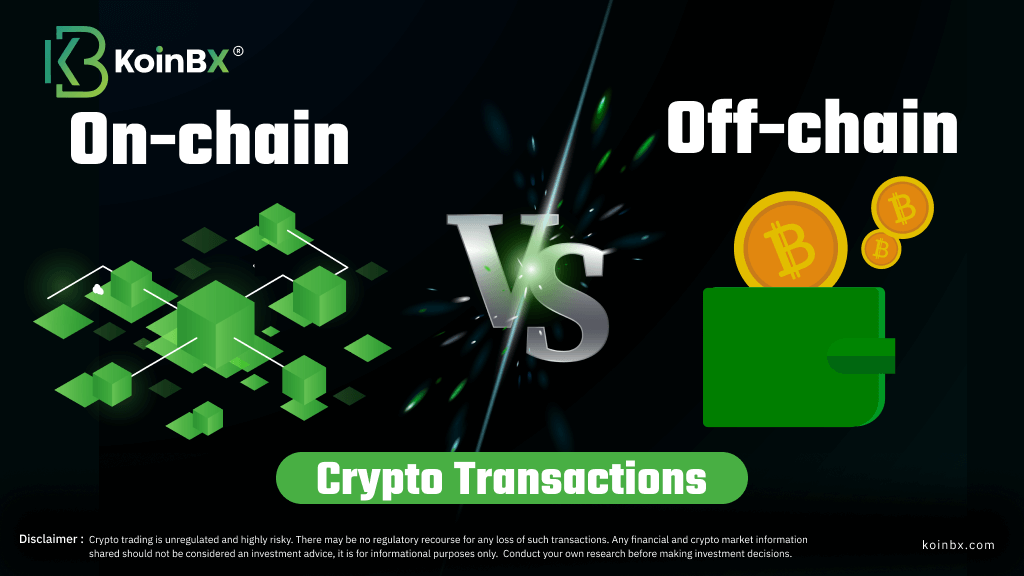Blockchain lets you handle crypto transactions without needing a middleman. On-chain transactions are more secure and clear because they are verified and saved on a public ledger that can't be interfered with.
However, these blockchain transactions might cost more and take longer to process, depending on how the network validates the transaction. For instance, getting a Bitcoin transaction confirmed on the Bitcoin network could take from a few minutes to a couple of days.
On the other hand, transactions done off-chain are confirmed outside the main blockchain network, which usually means they're cheaper and quicker for the person making the transaction.
Here is what sets on-chain and off-chain transactions apart. Let's learn together.
What is On-chain Transactions?
On-chain transactions happen right from start to finish on a blockchain network. Once it's checked and confirmed, it gets added to the blockchain's public ledger.
Here's how it all goes down: When two people want to swap crypto assets, they add all the transaction details and a timestamp on a digital file called a block. This block is then sent off to a blockchain network, where it remains until computers in the network, known as nodes, check it out and decide to add it to the blockchain.
There are a few ways to make sure transactions are checked and new blocks get added to a blockchain. Bitcoin, for instance, uses something called proof-of-work, where miners compete by using special computer programs to solve tough math problems to guess or match the "hash," and they get rewarded with some of the crypto assets. Newer methods, like proof-of-stake, don't need the math skill but instead, require participants to secure a certain amount of the blockchain's native crypto asset – their “stake” – to have the opportunity to validate a block of transactions.
Either way, these methods make sure transactions are secure and transparent because the transaction data is accessible to the public and is continuously reviewed and updated by the network of miners or validators. But, the complexity of these processes means that it can take some time to process each transaction and incorporate it into the blockchain.
Also Read: Layer 1 vs Layer 2 in Blockchain: Understanding the Differences
Advantages of On-chain Transactions
Security and Transparency: One of the main benefits of on-chain transactions is their security. Because each transaction is verified by multiple nodes and recorded on the blockchain, it’s extremely difficult to change. This process ensures transparency and trustworthiness.
Decentralization: On-chain transactions leverage the power of decentralization. Since they are validated by a distributed network of nodes, there is no central authority controlling the process. This reduces the risk of censorship and makes the system more robust.
Traceability: On-chain transactions can be easily traced and audited. Every transaction is recorded on the blockchain, allowing anyone to verify the movement of funds. This traceability is particularly useful for regulatory compliance.
What is off-chain Transactions?
On the other hand, transactions that occur outside the blockchain network shift some of the workload from the blockchain system, which can then be brought back into the blockchain. Within an off-chain network, participants decide that a third party will be responsible for verifying and confirming the transactions.
Off-chain solutions address the challenges of scalability within a blockchain network by enabling quicker and more affordable transactions. A specific approach to off-chain transactions involves using a layer 2, which is a secondary blockchain built above the primary blockchain (mainnet) to assist the mainnet in improving its speed and cost-effectiveness. This process moves transactions from the primary chain to a secondary chain, but for the purpose of this explanation, we will concentrate on other methods of off-chain transactions.
Also Read: The Future of Blockchain: Cross-Chain Interoperability Unveiled
Advantages of Off-Chain Transactions
Speed: One of the most significant benefits of off-chain transactions is speed. Since these transactions do not require validation by the entire network of nodes, they can be completed almost instantly. This makes off-chain transactions ideal for everyday purchases and high-frequency trading.
Lower Fees: On-chain transactions can sometimes incur high fees, especially during periods of network congestion. Off-chain transactions, on the other hand, generally have much lower fees because they do not require the same level of computational power and resources.
Privacy: Off-chain transactions can offer greater privacy. Since they are not recorded on the public blockchain, the details of these transactions are not visible to everyone. This can be particularly appealing for individuals and businesses that value discretion.
Final Thoughts
In conclusion, both on-chain and off-chain transactions play vital roles. On-chain transactions offer transparency, security, and decentralization, making them suitable for high-value and trust-sensitive exchanges. Off-chain transactions, with their speed, cost efficiency, and scalability, provide practical solutions for everyday transactions and high-frequency trading. Understanding the differences between these two types of transactions can help users make informed decisions based on their needs.
Download KoinBX Android App | Download KoinBX iOS App
Disclaimer: Any financial and crypto market information shared should not be considered investment advice. It is for informational purposes only. Conduct your own research before making investment decisions. Crypto trading is unregulated and highly risky. There may be no regulatory recourse for any loss of such transactions.






Comments